Action Research Proposal: Collaborative Learning in Humanities
VerifiedAdded on 2023/06/08
|8
|2177
|333
Project
AI Summary
This action research proposal investigates the impact of collaborative learning on student engagement within humanities education. The proposal outlines a project designed to explore whether collaborative learning strategies effectively support increased engagement in the classroom. The introduction defines collaborative learning, highlighting its benefits such as fostering higher-level thinking, communication, and self-management skills. The objectives include analyzing the effectiveness of collaborative learning, improving pedagogical practices in humanities, and identifying ways to boost student engagement. The proposal emphasizes the importance of this research in improving humanities teaching and learning practices, referencing relevant literature and research, including works by Ngyuen (2022), Heather (2018), and Best (2020). The methodology section details the research design, including the research philosophy (positivism), approach (deductive), strategy (survey), and method (quantitative). Data collection will involve primary data collection, and data analysis will use frequency data analysis. The proposal also addresses ethical considerations, focusing on protecting participant confidentiality and data integrity. The conclusion emphasizes the need for best practices in humanities education, highlighting the significance of collaborative learning for student development and the importance of research in this area. Overall, the proposal provides a comprehensive plan to investigate and improve teaching and learning practices in humanities through the lens of collaborative learning.

Action research proposal
Secure Best Marks with AI Grader
Need help grading? Try our AI Grader for instant feedback on your assignments.
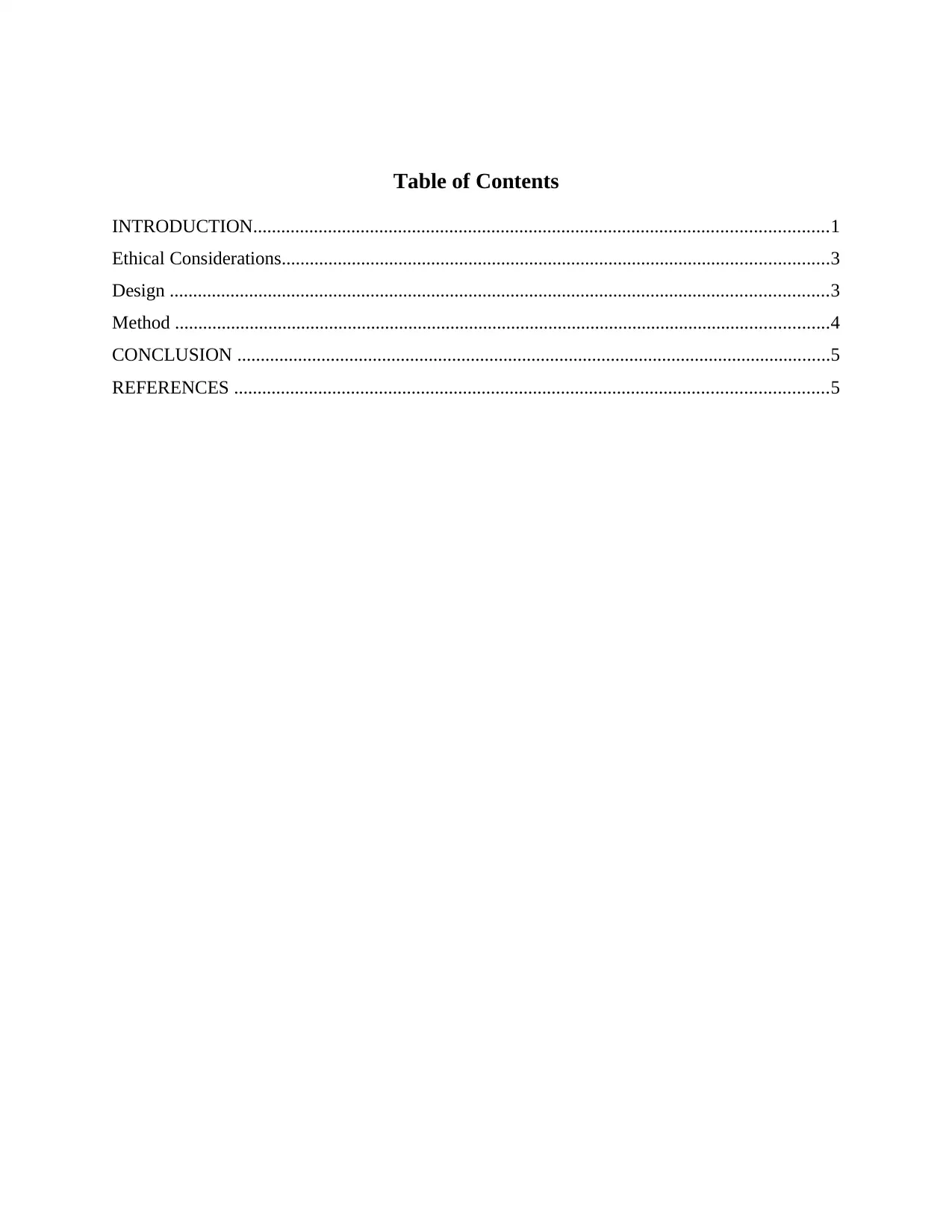
Table of Contents
INTRODUCTION...........................................................................................................................1
Ethical Considerations.....................................................................................................................3
Design .............................................................................................................................................3
Method ............................................................................................................................................4
CONCLUSION ...............................................................................................................................5
REFERENCES ...............................................................................................................................5
INTRODUCTION...........................................................................................................................1
Ethical Considerations.....................................................................................................................3
Design .............................................................................................................................................3
Method ............................................................................................................................................4
CONCLUSION ...............................................................................................................................5
REFERENCES ...............................................................................................................................5
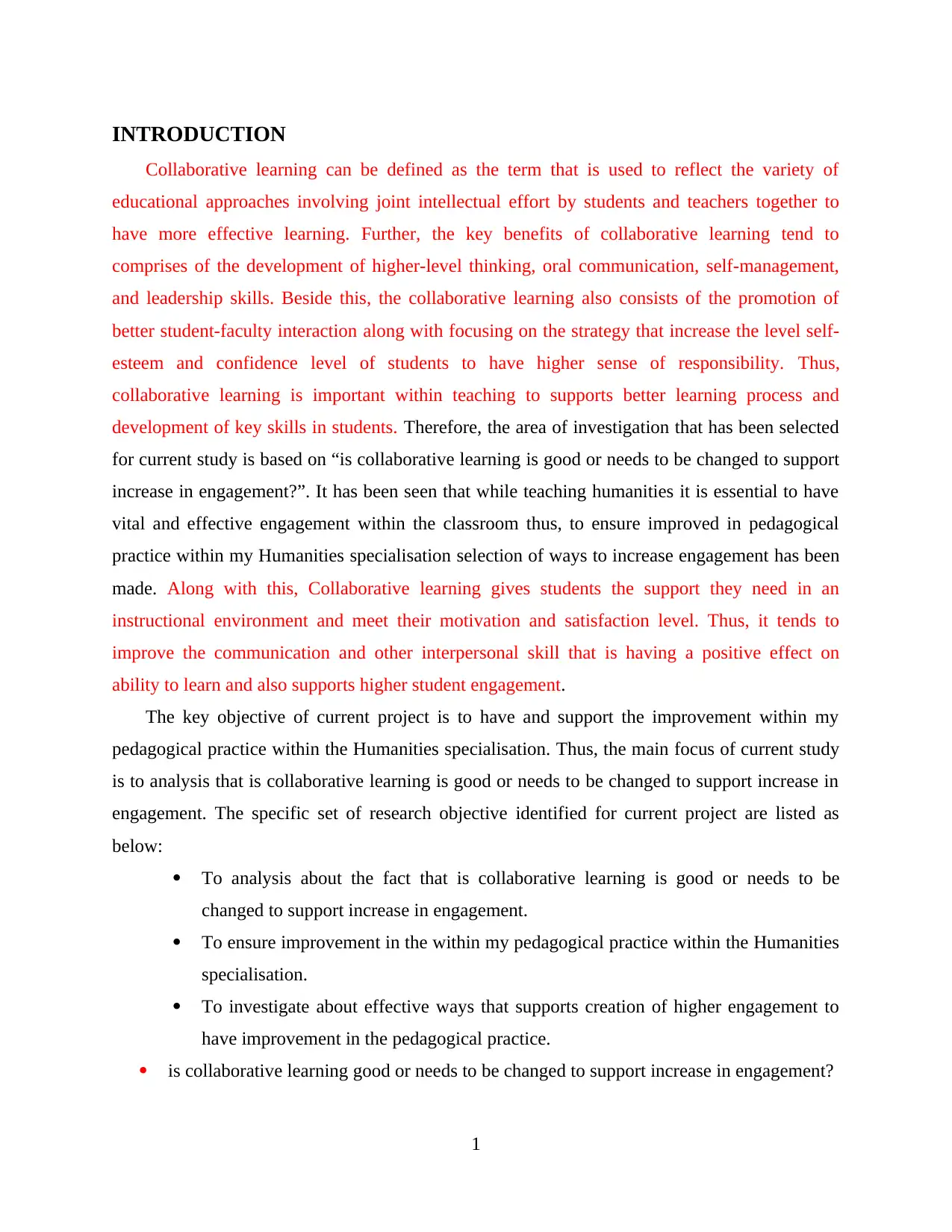
INTRODUCTION
Collaborative learning can be defined as the term that is used to reflect the variety of
educational approaches involving joint intellectual effort by students and teachers together to
have more effective learning. Further, the key benefits of collaborative learning tend to
comprises of the development of higher-level thinking, oral communication, self-management,
and leadership skills. Beside this, the collaborative learning also consists of the promotion of
better student-faculty interaction along with focusing on the strategy that increase the level self-
esteem and confidence level of students to have higher sense of responsibility. Thus,
collaborative learning is important within teaching to supports better learning process and
development of key skills in students. Therefore, the area of investigation that has been selected
for current study is based on “is collaborative learning is good or needs to be changed to support
increase in engagement?”. It has been seen that while teaching humanities it is essential to have
vital and effective engagement within the classroom thus, to ensure improved in pedagogical
practice within my Humanities specialisation selection of ways to increase engagement has been
made. Along with this, Collaborative learning gives students the support they need in an
instructional environment and meet their motivation and satisfaction level. Thus, it tends to
improve the communication and other interpersonal skill that is having a positive effect on
ability to learn and also supports higher student engagement.
The key objective of current project is to have and support the improvement within my
pedagogical practice within the Humanities specialisation. Thus, the main focus of current study
is to analysis that is collaborative learning is good or needs to be changed to support increase in
engagement. The specific set of research objective identified for current project are listed as
below:
To analysis about the fact that is collaborative learning is good or needs to be
changed to support increase in engagement.
To ensure improvement in the within my pedagogical practice within the Humanities
specialisation.
To investigate about effective ways that supports creation of higher engagement to
have improvement in the pedagogical practice.
is collaborative learning good or needs to be changed to support increase in engagement?
1
Collaborative learning can be defined as the term that is used to reflect the variety of
educational approaches involving joint intellectual effort by students and teachers together to
have more effective learning. Further, the key benefits of collaborative learning tend to
comprises of the development of higher-level thinking, oral communication, self-management,
and leadership skills. Beside this, the collaborative learning also consists of the promotion of
better student-faculty interaction along with focusing on the strategy that increase the level self-
esteem and confidence level of students to have higher sense of responsibility. Thus,
collaborative learning is important within teaching to supports better learning process and
development of key skills in students. Therefore, the area of investigation that has been selected
for current study is based on “is collaborative learning is good or needs to be changed to support
increase in engagement?”. It has been seen that while teaching humanities it is essential to have
vital and effective engagement within the classroom thus, to ensure improved in pedagogical
practice within my Humanities specialisation selection of ways to increase engagement has been
made. Along with this, Collaborative learning gives students the support they need in an
instructional environment and meet their motivation and satisfaction level. Thus, it tends to
improve the communication and other interpersonal skill that is having a positive effect on
ability to learn and also supports higher student engagement.
The key objective of current project is to have and support the improvement within my
pedagogical practice within the Humanities specialisation. Thus, the main focus of current study
is to analysis that is collaborative learning is good or needs to be changed to support increase in
engagement. The specific set of research objective identified for current project are listed as
below:
To analysis about the fact that is collaborative learning is good or needs to be
changed to support increase in engagement.
To ensure improvement in the within my pedagogical practice within the Humanities
specialisation.
To investigate about effective ways that supports creation of higher engagement to
have improvement in the pedagogical practice.
is collaborative learning good or needs to be changed to support increase in engagement?
1
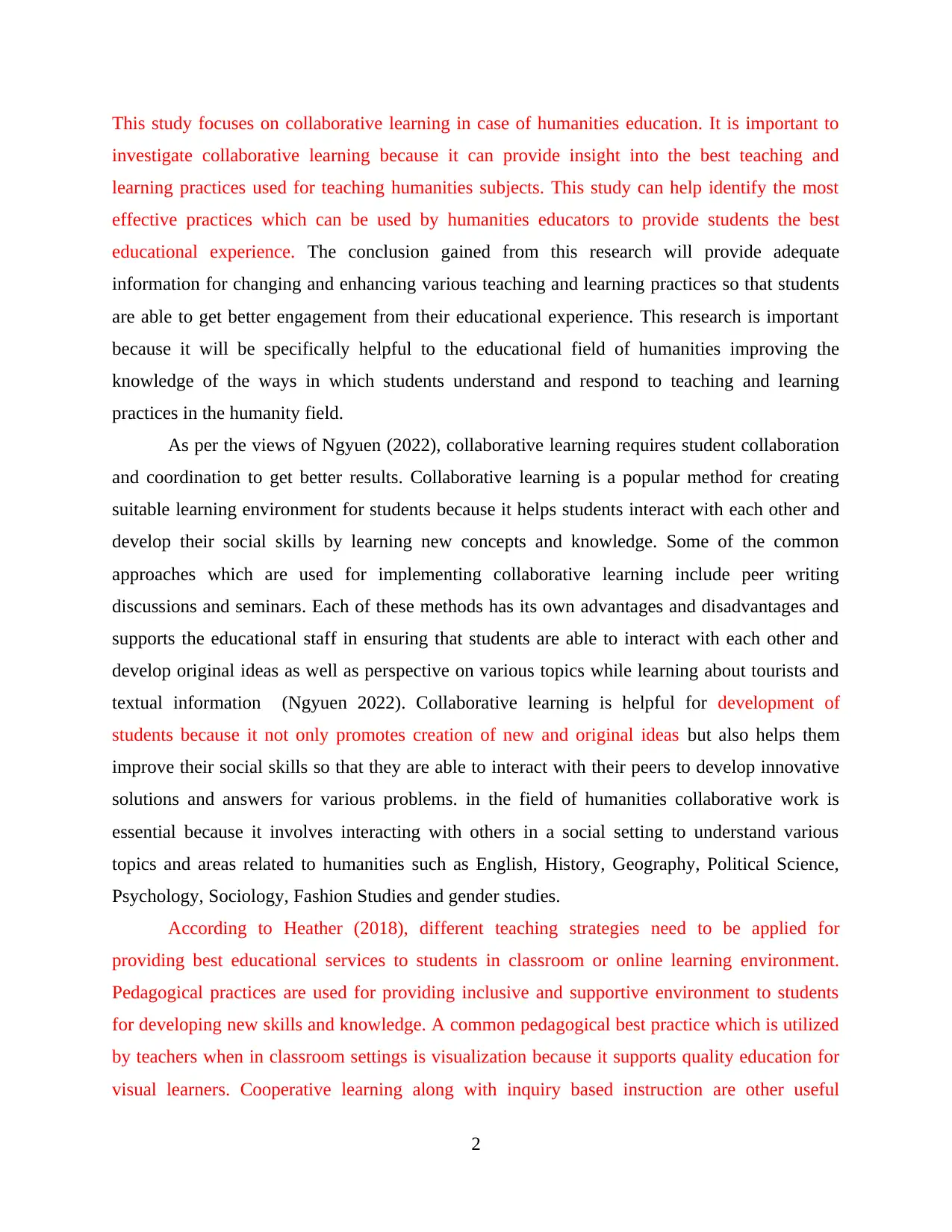
This study focuses on collaborative learning in case of humanities education. It is important to
investigate collaborative learning because it can provide insight into the best teaching and
learning practices used for teaching humanities subjects. This study can help identify the most
effective practices which can be used by humanities educators to provide students the best
educational experience. The conclusion gained from this research will provide adequate
information for changing and enhancing various teaching and learning practices so that students
are able to get better engagement from their educational experience. This research is important
because it will be specifically helpful to the educational field of humanities improving the
knowledge of the ways in which students understand and respond to teaching and learning
practices in the humanity field.
As per the views of Ngyuen (2022), collaborative learning requires student collaboration
and coordination to get better results. Collaborative learning is a popular method for creating
suitable learning environment for students because it helps students interact with each other and
develop their social skills by learning new concepts and knowledge. Some of the common
approaches which are used for implementing collaborative learning include peer writing
discussions and seminars. Each of these methods has its own advantages and disadvantages and
supports the educational staff in ensuring that students are able to interact with each other and
develop original ideas as well as perspective on various topics while learning about tourists and
textual information (Ngyuen 2022). Collaborative learning is helpful for development of
students because it not only promotes creation of new and original ideas but also helps them
improve their social skills so that they are able to interact with their peers to develop innovative
solutions and answers for various problems. in the field of humanities collaborative work is
essential because it involves interacting with others in a social setting to understand various
topics and areas related to humanities such as English, History, Geography, Political Science,
Psychology, Sociology, Fashion Studies and gender studies.
According to Heather (2018), different teaching strategies need to be applied for
providing best educational services to students in classroom or online learning environment.
Pedagogical practices are used for providing inclusive and supportive environment to students
for developing new skills and knowledge. A common pedagogical best practice which is utilized
by teachers when in classroom settings is visualization because it supports quality education for
visual learners. Cooperative learning along with inquiry based instruction are other useful
2
investigate collaborative learning because it can provide insight into the best teaching and
learning practices used for teaching humanities subjects. This study can help identify the most
effective practices which can be used by humanities educators to provide students the best
educational experience. The conclusion gained from this research will provide adequate
information for changing and enhancing various teaching and learning practices so that students
are able to get better engagement from their educational experience. This research is important
because it will be specifically helpful to the educational field of humanities improving the
knowledge of the ways in which students understand and respond to teaching and learning
practices in the humanity field.
As per the views of Ngyuen (2022), collaborative learning requires student collaboration
and coordination to get better results. Collaborative learning is a popular method for creating
suitable learning environment for students because it helps students interact with each other and
develop their social skills by learning new concepts and knowledge. Some of the common
approaches which are used for implementing collaborative learning include peer writing
discussions and seminars. Each of these methods has its own advantages and disadvantages and
supports the educational staff in ensuring that students are able to interact with each other and
develop original ideas as well as perspective on various topics while learning about tourists and
textual information (Ngyuen 2022). Collaborative learning is helpful for development of
students because it not only promotes creation of new and original ideas but also helps them
improve their social skills so that they are able to interact with their peers to develop innovative
solutions and answers for various problems. in the field of humanities collaborative work is
essential because it involves interacting with others in a social setting to understand various
topics and areas related to humanities such as English, History, Geography, Political Science,
Psychology, Sociology, Fashion Studies and gender studies.
According to Heather (2018), different teaching strategies need to be applied for
providing best educational services to students in classroom or online learning environment.
Pedagogical practices are used for providing inclusive and supportive environment to students
for developing new skills and knowledge. A common pedagogical best practice which is utilized
by teachers when in classroom settings is visualization because it supports quality education for
visual learners. Cooperative learning along with inquiry based instruction are other useful
2
Secure Best Marks with AI Grader
Need help grading? Try our AI Grader for instant feedback on your assignments.
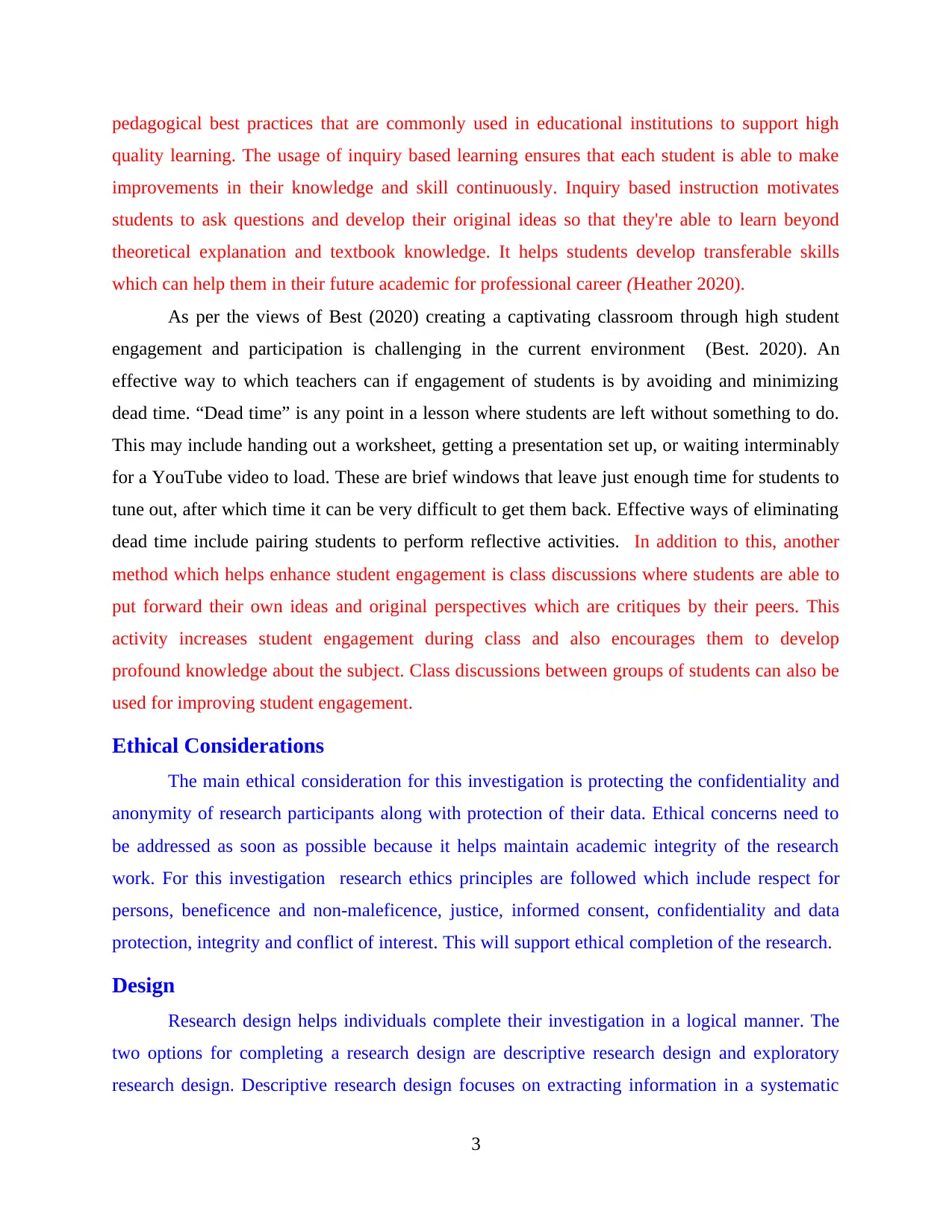
pedagogical best practices that are commonly used in educational institutions to support high
quality learning. The usage of inquiry based learning ensures that each student is able to make
improvements in their knowledge and skill continuously. Inquiry based instruction motivates
students to ask questions and develop their original ideas so that they're able to learn beyond
theoretical explanation and textbook knowledge. It helps students develop transferable skills
which can help them in their future academic for professional career (Heather 2020).
As per the views of Best (2020) creating a captivating classroom through high student
engagement and participation is challenging in the current environment (Best. 2020). An
effective way to which teachers can if engagement of students is by avoiding and minimizing
dead time. “Dead time” is any point in a lesson where students are left without something to do.
This may include handing out a worksheet, getting a presentation set up, or waiting interminably
for a YouTube video to load. These are brief windows that leave just enough time for students to
tune out, after which time it can be very difficult to get them back. Effective ways of eliminating
dead time include pairing students to perform reflective activities. In addition to this, another
method which helps enhance student engagement is class discussions where students are able to
put forward their own ideas and original perspectives which are critiques by their peers. This
activity increases student engagement during class and also encourages them to develop
profound knowledge about the subject. Class discussions between groups of students can also be
used for improving student engagement.
Ethical Considerations
The main ethical consideration for this investigation is protecting the confidentiality and
anonymity of research participants along with protection of their data. Ethical concerns need to
be addressed as soon as possible because it helps maintain academic integrity of the research
work. For this investigation research ethics principles are followed which include respect for
persons, beneficence and non-maleficence, justice, informed consent, confidentiality and data
protection, integrity and conflict of interest. This will support ethical completion of the research.
Design
Research design helps individuals complete their investigation in a logical manner. The
two options for completing a research design are descriptive research design and exploratory
research design. Descriptive research design focuses on extracting information in a systematic
3
quality learning. The usage of inquiry based learning ensures that each student is able to make
improvements in their knowledge and skill continuously. Inquiry based instruction motivates
students to ask questions and develop their original ideas so that they're able to learn beyond
theoretical explanation and textbook knowledge. It helps students develop transferable skills
which can help them in their future academic for professional career (Heather 2020).
As per the views of Best (2020) creating a captivating classroom through high student
engagement and participation is challenging in the current environment (Best. 2020). An
effective way to which teachers can if engagement of students is by avoiding and minimizing
dead time. “Dead time” is any point in a lesson where students are left without something to do.
This may include handing out a worksheet, getting a presentation set up, or waiting interminably
for a YouTube video to load. These are brief windows that leave just enough time for students to
tune out, after which time it can be very difficult to get them back. Effective ways of eliminating
dead time include pairing students to perform reflective activities. In addition to this, another
method which helps enhance student engagement is class discussions where students are able to
put forward their own ideas and original perspectives which are critiques by their peers. This
activity increases student engagement during class and also encourages them to develop
profound knowledge about the subject. Class discussions between groups of students can also be
used for improving student engagement.
Ethical Considerations
The main ethical consideration for this investigation is protecting the confidentiality and
anonymity of research participants along with protection of their data. Ethical concerns need to
be addressed as soon as possible because it helps maintain academic integrity of the research
work. For this investigation research ethics principles are followed which include respect for
persons, beneficence and non-maleficence, justice, informed consent, confidentiality and data
protection, integrity and conflict of interest. This will support ethical completion of the research.
Design
Research design helps individuals complete their investigation in a logical manner. The
two options for completing a research design are descriptive research design and exploratory
research design. Descriptive research design focuses on extracting information in a systematic
3
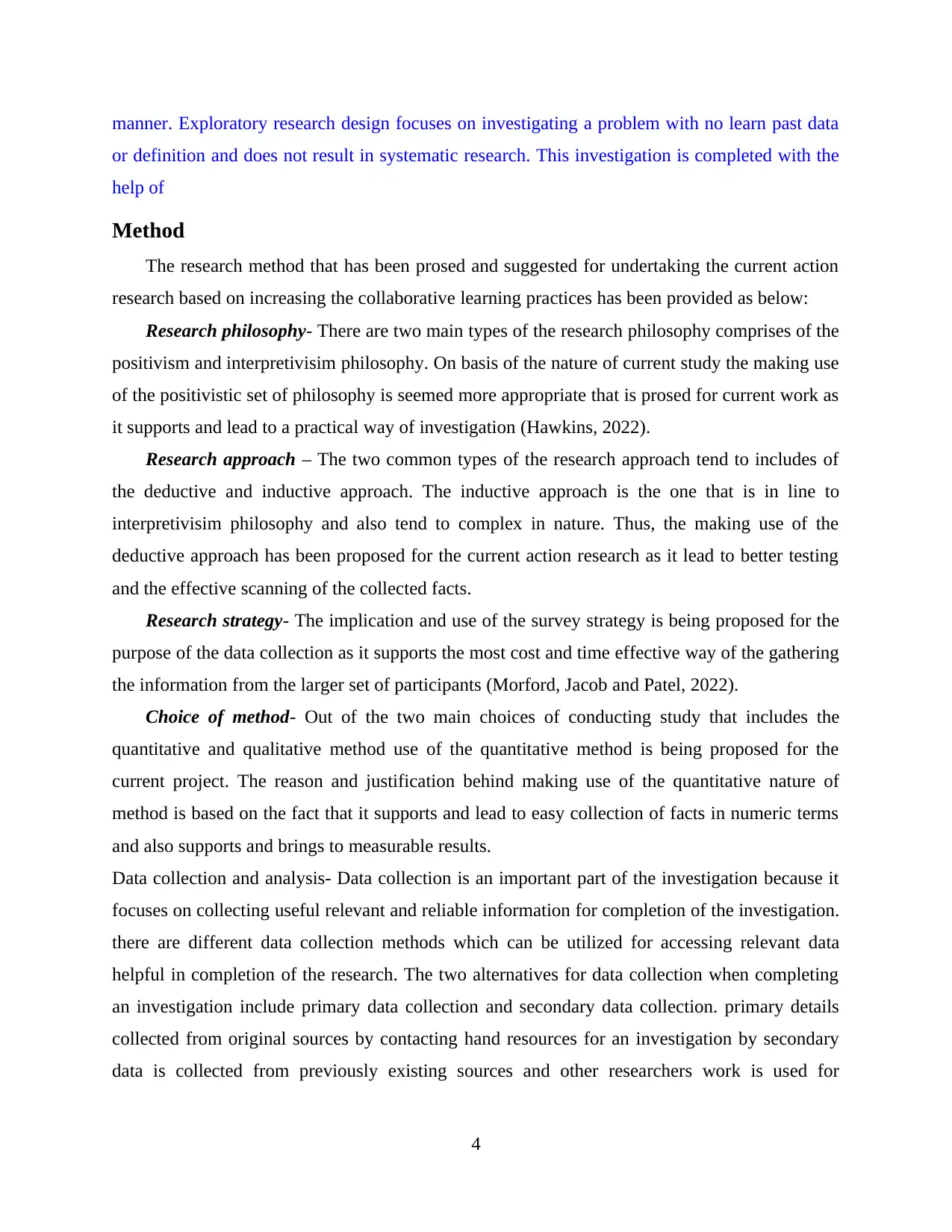
manner. Exploratory research design focuses on investigating a problem with no learn past data
or definition and does not result in systematic research. This investigation is completed with the
help of
Method
The research method that has been prosed and suggested for undertaking the current action
research based on increasing the collaborative learning practices has been provided as below:
Research philosophy- There are two main types of the research philosophy comprises of the
positivism and interpretivisim philosophy. On basis of the nature of current study the making use
of the positivistic set of philosophy is seemed more appropriate that is prosed for current work as
it supports and lead to a practical way of investigation (Hawkins, 2022).
Research approach – The two common types of the research approach tend to includes of
the deductive and inductive approach. The inductive approach is the one that is in line to
interpretivisim philosophy and also tend to complex in nature. Thus, the making use of the
deductive approach has been proposed for the current action research as it lead to better testing
and the effective scanning of the collected facts.
Research strategy- The implication and use of the survey strategy is being proposed for the
purpose of the data collection as it supports the most cost and time effective way of the gathering
the information from the larger set of participants (Morford, Jacob and Patel, 2022).
Choice of method- Out of the two main choices of conducting study that includes the
quantitative and qualitative method use of the quantitative method is being proposed for the
current project. The reason and justification behind making use of the quantitative nature of
method is based on the fact that it supports and lead to easy collection of facts in numeric terms
and also supports and brings to measurable results.
Data collection and analysis- Data collection is an important part of the investigation because it
focuses on collecting useful relevant and reliable information for completion of the investigation.
there are different data collection methods which can be utilized for accessing relevant data
helpful in completion of the research. The two alternatives for data collection when completing
an investigation include primary data collection and secondary data collection. primary details
collected from original sources by contacting hand resources for an investigation by secondary
data is collected from previously existing sources and other researchers work is used for
4
or definition and does not result in systematic research. This investigation is completed with the
help of
Method
The research method that has been prosed and suggested for undertaking the current action
research based on increasing the collaborative learning practices has been provided as below:
Research philosophy- There are two main types of the research philosophy comprises of the
positivism and interpretivisim philosophy. On basis of the nature of current study the making use
of the positivistic set of philosophy is seemed more appropriate that is prosed for current work as
it supports and lead to a practical way of investigation (Hawkins, 2022).
Research approach – The two common types of the research approach tend to includes of
the deductive and inductive approach. The inductive approach is the one that is in line to
interpretivisim philosophy and also tend to complex in nature. Thus, the making use of the
deductive approach has been proposed for the current action research as it lead to better testing
and the effective scanning of the collected facts.
Research strategy- The implication and use of the survey strategy is being proposed for the
purpose of the data collection as it supports the most cost and time effective way of the gathering
the information from the larger set of participants (Morford, Jacob and Patel, 2022).
Choice of method- Out of the two main choices of conducting study that includes the
quantitative and qualitative method use of the quantitative method is being proposed for the
current project. The reason and justification behind making use of the quantitative nature of
method is based on the fact that it supports and lead to easy collection of facts in numeric terms
and also supports and brings to measurable results.
Data collection and analysis- Data collection is an important part of the investigation because it
focuses on collecting useful relevant and reliable information for completion of the investigation.
there are different data collection methods which can be utilized for accessing relevant data
helpful in completion of the research. The two alternatives for data collection when completing
an investigation include primary data collection and secondary data collection. primary details
collected from original sources by contacting hand resources for an investigation by secondary
data is collected from previously existing sources and other researchers work is used for
4
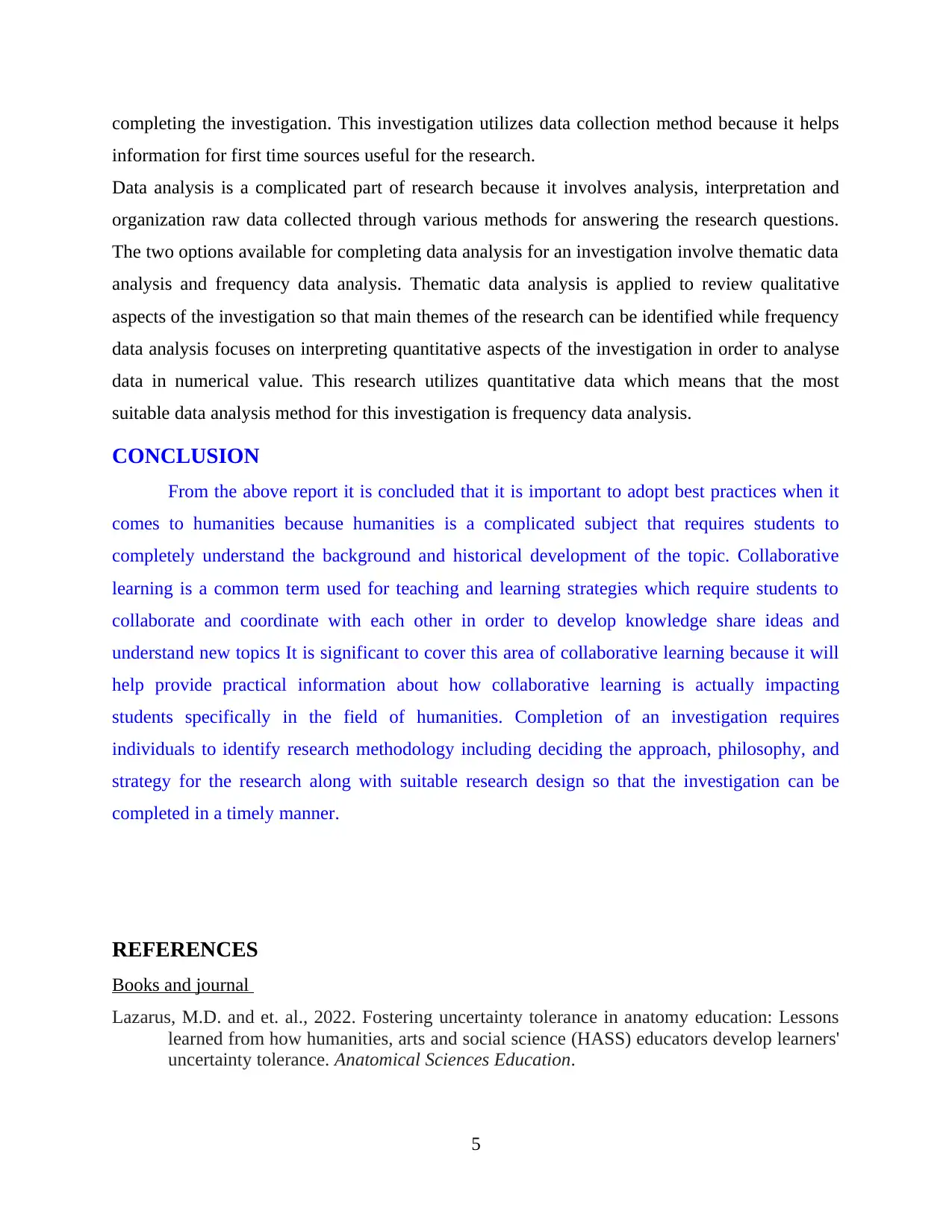
completing the investigation. This investigation utilizes data collection method because it helps
information for first time sources useful for the research.
Data analysis is a complicated part of research because it involves analysis, interpretation and
organization raw data collected through various methods for answering the research questions.
The two options available for completing data analysis for an investigation involve thematic data
analysis and frequency data analysis. Thematic data analysis is applied to review qualitative
aspects of the investigation so that main themes of the research can be identified while frequency
data analysis focuses on interpreting quantitative aspects of the investigation in order to analyse
data in numerical value. This research utilizes quantitative data which means that the most
suitable data analysis method for this investigation is frequency data analysis.
CONCLUSION
From the above report it is concluded that it is important to adopt best practices when it
comes to humanities because humanities is a complicated subject that requires students to
completely understand the background and historical development of the topic. Collaborative
learning is a common term used for teaching and learning strategies which require students to
collaborate and coordinate with each other in order to develop knowledge share ideas and
understand new topics It is significant to cover this area of collaborative learning because it will
help provide practical information about how collaborative learning is actually impacting
students specifically in the field of humanities. Completion of an investigation requires
individuals to identify research methodology including deciding the approach, philosophy, and
strategy for the research along with suitable research design so that the investigation can be
completed in a timely manner.
REFERENCES
Books and journal
Lazarus, M.D. and et. al., 2022. Fostering uncertainty tolerance in anatomy education: Lessons
learned from how humanities, arts and social science (HASS) educators develop learners'
uncertainty tolerance. Anatomical Sciences Education.
5
information for first time sources useful for the research.
Data analysis is a complicated part of research because it involves analysis, interpretation and
organization raw data collected through various methods for answering the research questions.
The two options available for completing data analysis for an investigation involve thematic data
analysis and frequency data analysis. Thematic data analysis is applied to review qualitative
aspects of the investigation so that main themes of the research can be identified while frequency
data analysis focuses on interpreting quantitative aspects of the investigation in order to analyse
data in numerical value. This research utilizes quantitative data which means that the most
suitable data analysis method for this investigation is frequency data analysis.
CONCLUSION
From the above report it is concluded that it is important to adopt best practices when it
comes to humanities because humanities is a complicated subject that requires students to
completely understand the background and historical development of the topic. Collaborative
learning is a common term used for teaching and learning strategies which require students to
collaborate and coordinate with each other in order to develop knowledge share ideas and
understand new topics It is significant to cover this area of collaborative learning because it will
help provide practical information about how collaborative learning is actually impacting
students specifically in the field of humanities. Completion of an investigation requires
individuals to identify research methodology including deciding the approach, philosophy, and
strategy for the research along with suitable research design so that the investigation can be
completed in a timely manner.
REFERENCES
Books and journal
Lazarus, M.D. and et. al., 2022. Fostering uncertainty tolerance in anatomy education: Lessons
learned from how humanities, arts and social science (HASS) educators develop learners'
uncertainty tolerance. Anatomical Sciences Education.
5
Paraphrase This Document
Need a fresh take? Get an instant paraphrase of this document with our AI Paraphraser
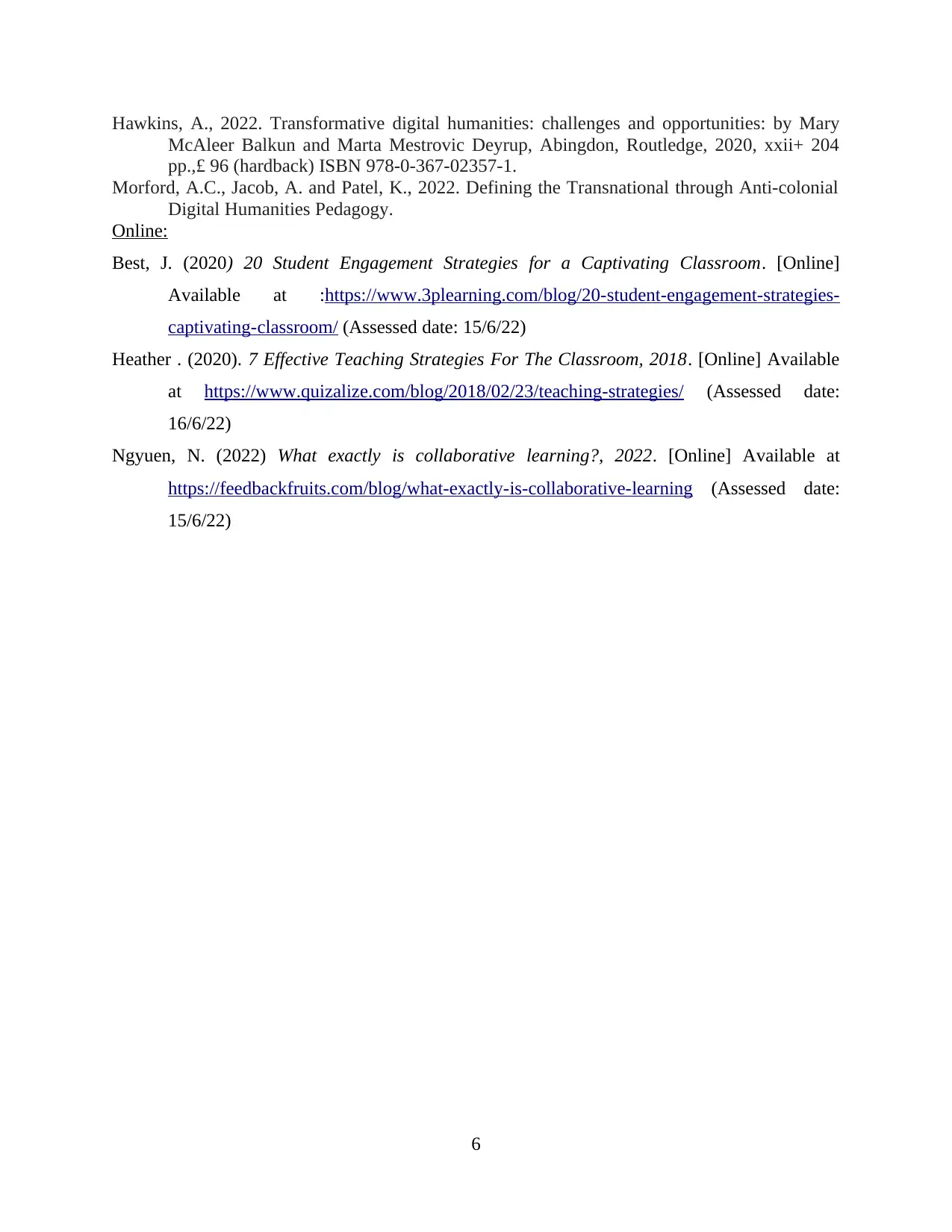
Hawkins, A., 2022. Transformative digital humanities: challenges and opportunities: by Mary
McAleer Balkun and Marta Mestrovic Deyrup, Abingdon, Routledge, 2020, xxii+ 204
pp.,£ 96 (hardback) ISBN 978-0-367-02357-1.
Morford, A.C., Jacob, A. and Patel, K., 2022. Defining the Transnational through Anti-colonial
Digital Humanities Pedagogy.
Online:
Best, J. (2020) 20 Student Engagement Strategies for a Captivating Classroom. [Online]
Available at :https://www.3plearning.com/blog/20-student-engagement-strategies-
captivating-classroom/ (Assessed date: 15/6/22)
Heather . (2020). 7 Effective Teaching Strategies For The Classroom, 2018. [Online] Available
at https://www.quizalize.com/blog/2018/02/23/teaching-strategies/ (Assessed date:
16/6/22)
Ngyuen, N. (2022) What exactly is collaborative learning?, 2022. [Online] Available at
https://feedbackfruits.com/blog/what-exactly-is-collaborative-learning (Assessed date:
15/6/22)
6
McAleer Balkun and Marta Mestrovic Deyrup, Abingdon, Routledge, 2020, xxii+ 204
pp.,£ 96 (hardback) ISBN 978-0-367-02357-1.
Morford, A.C., Jacob, A. and Patel, K., 2022. Defining the Transnational through Anti-colonial
Digital Humanities Pedagogy.
Online:
Best, J. (2020) 20 Student Engagement Strategies for a Captivating Classroom. [Online]
Available at :https://www.3plearning.com/blog/20-student-engagement-strategies-
captivating-classroom/ (Assessed date: 15/6/22)
Heather . (2020). 7 Effective Teaching Strategies For The Classroom, 2018. [Online] Available
at https://www.quizalize.com/blog/2018/02/23/teaching-strategies/ (Assessed date:
16/6/22)
Ngyuen, N. (2022) What exactly is collaborative learning?, 2022. [Online] Available at
https://feedbackfruits.com/blog/what-exactly-is-collaborative-learning (Assessed date:
15/6/22)
6
1 out of 8
Related Documents
Your All-in-One AI-Powered Toolkit for Academic Success.
+13062052269
info@desklib.com
Available 24*7 on WhatsApp / Email
![[object Object]](/_next/static/media/star-bottom.7253800d.svg)
Unlock your academic potential
© 2024 | Zucol Services PVT LTD | All rights reserved.





